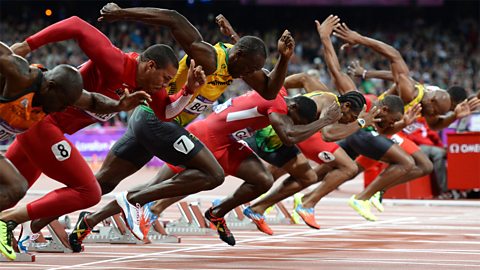Muscle fibres

The human body contains different types of muscle fibres:
- Cardiac muscle - unique to the heart - never tires.
- Involuntary muscles - work our internal organs - outside our control.
- Voluntary muscles make the body move - attached to the skeleton (also called skeletal muscles) - can be controlled.
Skeletal muscle fibres
There are two types of skeletal muscle fibres:
- fast-twitch - contract quickly - do not use oxygen well - tire quickly
- slow-twitch - contract slowly - use oxygen well - keep going for a long time
The two types of fibre are different because they have different numbers of mitochondria, blood supplies and concentrations of the oxygen-storing protein myoglobin.
| Slow-twitch | Fast-twitch | |
| Speed of contraction | Slowly | Quickly |
| Length of time contractions can be sustained | Long periods of time | Short periods of time |
| Activities used for | Long distance running | Sprinting |
| How they generate ATP | Aerobic respiration | Glycolysis only |
| Number of mitochondria | Many | Few |
| Blood supply | Large | Low |
| Myoglobin concentration | High | Low |
| Storage fuel | Fats | Glycogen |
| Speed of contraction | |
| Slow-twitch | Slowly |
| Fast-twitch | Quickly |
| Length of time contractions can be sustained | |
| Slow-twitch | Long periods of time |
| Fast-twitch | Short periods of time |
| Activities used for | |
| Slow-twitch | Long distance running |
| Fast-twitch | Sprinting |
| How they generate ATP | |
| Slow-twitch | Aerobic respiration |
| Fast-twitch | Glycolysis only |
| Number of mitochondria | |
| Slow-twitch | Many |
| Fast-twitch | Few |
| Blood supply | |
| Slow-twitch | Large |
| Fast-twitch | Low |
| Myoglobin concentration | |
| Slow-twitch | High |
| Fast-twitch | Low |
| Storage fuel | |
| Slow-twitch | Fats |
| Fast-twitch | Glycogen |
For most people muscle tissue contains a combination of both slow and fast-twitch fibres. Athletes are more likely to have distinct fibre patterns dependent on which sporting activity they take part in.
Top sprinters have more 'fast-twitch' fibres. Endurance athletes tend to have more 'slow-twitch' fibres.